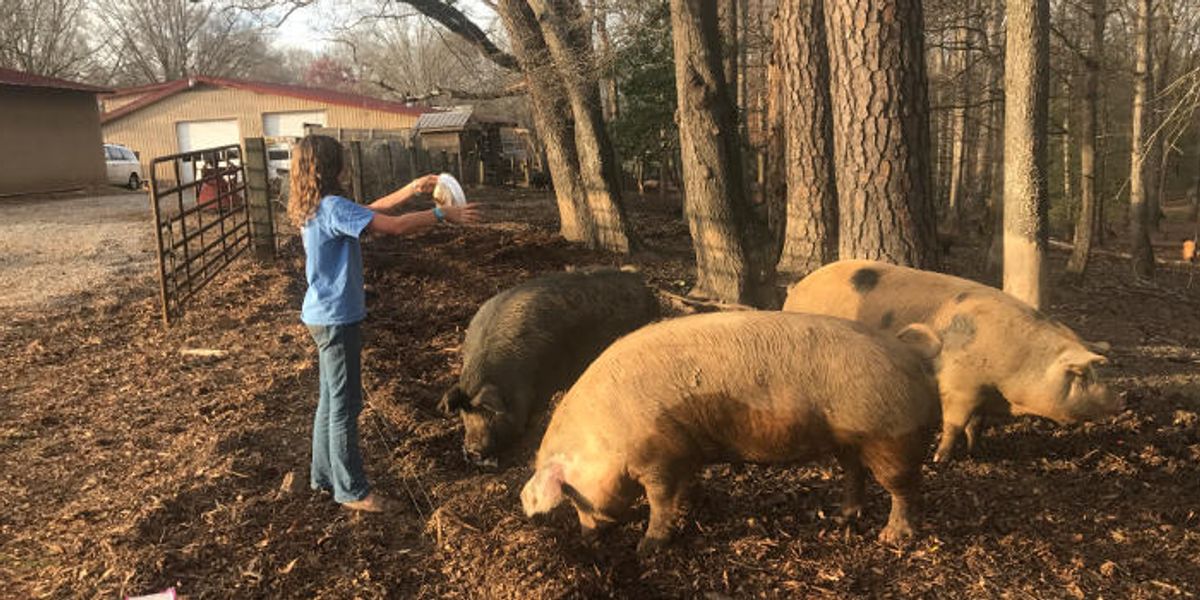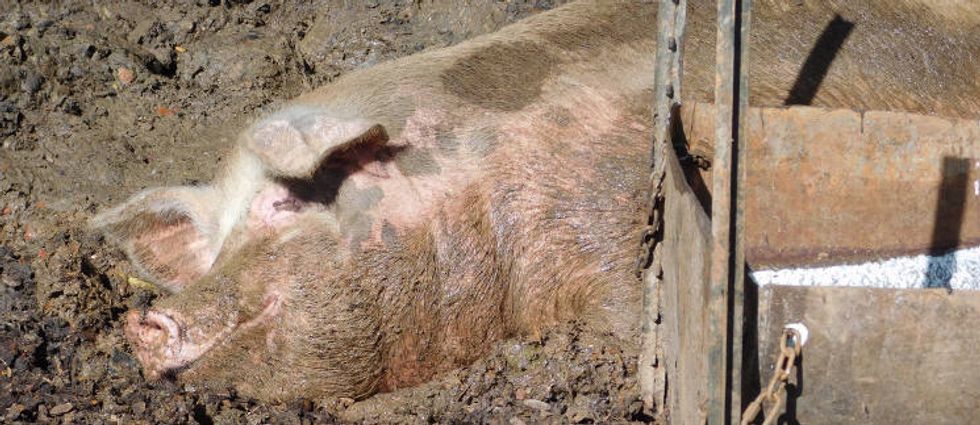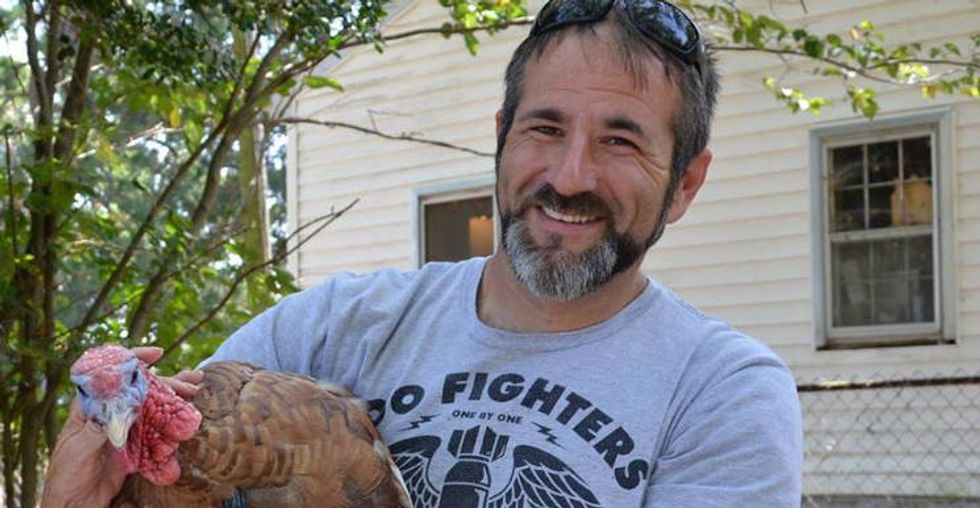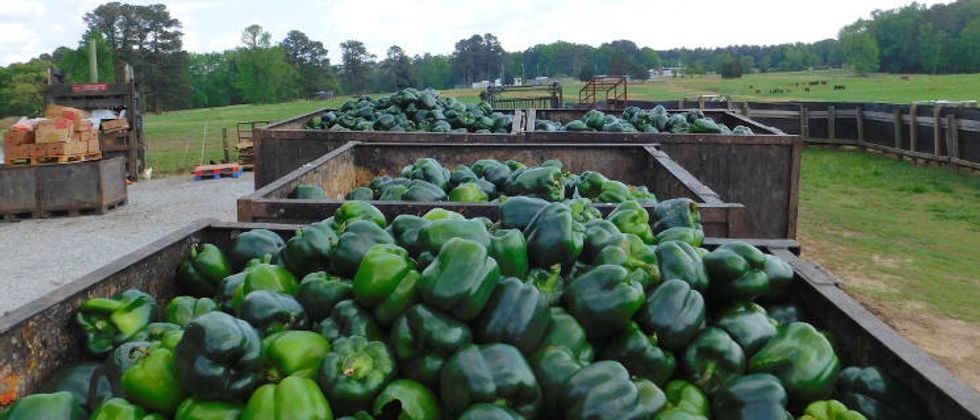
Bringing the “farm” back to hog farming
A look at the economics and scalability of raising hogs outside—and the characters doing it
RALEIGH, N.C.—Dan Moore's farm marks an abrupt exit from the fringes of suburbia: cookie cooker homes give way as a rolling road weaves you through a dense canopy of deciduous trees.
It would be easy to miss the driveway but for a small sign of a cartoon cow with a sword, the logo for the family farm dubbed, of course, Ninja Cow.
Moore's family has deep roots in North Carolina. His relatives have farmed here for more than a century.
"I tried to leave like most farm kids but got pulled back," Moore tells me on a mid-80s day in April, right before his busy season. The 84-acre Ninja Cow Farm (named after a difficult and elusive cow from years past) is just 20 minutes south of downtown Raleigh. Approaching the farm, you see the hallmarks of encroaching sprawl—manicured lawns, fastidious landscaping, subdivisions. Moore's plot of Earth is wild, well protected, covered by trees—with the hallmarks of people and animals at work.
The farm is half pasture, half wooded. Moore's hogs roam and root among the trees. They squeal, nudge one another, burrow in mud and eat from piles of would-be-wasted Raleigh Farmer's Market produce.
Moore, sporting a flat-brimmed straw farmers hat, dark shades, khaki shorts, sandals and an orange shirt with the Ninja Cow logo, leads me to a 4x4 Gator vehicle for a tour.
His slight drawl, pork business ties and family roots make him pure North Carolina. But his unorthodox, stench-free farm of free-range pigs and cows is an anomalous outlier in a state—and country—where most hogs are raised in buildings, confined by metal cages and subject neighbors to overwhelming smells and polluted waterways.
Economists and researchers say the market is stacked against farmers like Moore. Outdoor hog production has a place, but it's "clearly a niche," says John McGlone of Texas Tech University, who has been researching different techniques of hog raising for years.
His answer on the future is not nuanced: "It's indoors." The reasons are simple: More control, more consistency, lower costs.
However, meat eaters are increasingly looking for local, humane, environmentally friendly pork. Ninja Cow isn't technically a "pasture farm" since the hogs are feeding on produce from the farmer's market and roaming the woods. But it's unquestionably a farm: And that lies at the heart of a move toward raising hogs outside—both from the farmer's and consumer's point of view.
Advocates of outdoor hog raising say the industry model is simply hiding costs in excess pollution, government subsidies and lax regulation.
"Commodity pork is not the true cost of food," says Ross Duffield, farm manager with the Rodale Institute, a Pennsylvania-based research institute advocating for organic farming. "We need to get back in touch with farmers, and farmers need to let consumers know hog pork is raised."Purchase power

A muddy, seemingly happy hog, at Ninja Cow Farm. (Credit: Brian Bienkowski/EHN)
Over the past four decades, the total U.S. inventory of hogs has remained consistent while the number of farms plummeted by 87 percent.
In 1977 there were more than a half million hog farm operations. There are now 63,236, according to the latest U.S. Department of Agriculture Census. Almost half the total hogs in the country are raised on farms with more than 5,000 head and under contract to a larger entity, like Smithfield Foods or Cargill.
Accounting for just a sliver of hogs produced are the 70 percent of U.S. hog farms that have less than 100 hogs. The federal government doesn't tally how many farmers are raising hogs on pasture. The number is definitely low.
But data does exist on consumers seeking pasture-raised or organic pork. And it's moving in favor of folks like Moore.
Free-range (or vegetarian-fed) meat is now a $40 million business, based on nationwide shopper data analyzed by the Food Marketing Institute and North American Meat Institute. That is paltry compared to the $32 billion market for conventional meat. But the free-range business, in dollars, has grown 87 percent over the past decade, while conventional meat sales are down 4 percent.
US organic food purchases continue to break records, topping $43 billion, according to the latest report from the Organic Trade Association. Organic meat, with a dollar total of $474 million, grew 13 percent in dollars and 9 percent in volume over the past decade.
"Small, midsize farms are finding powerful friends—consumers," says Chris Petersen, an Iowa farmer who raises a couple hundred black Berkshire hogs a year and advocates nationally for small farmers.
Just a few hours drive from Moore are the huge industrial hog farms where thousands of animals are kept in metal cages. The top two hog producing counties in the U.S. are in North Carolina—Duplin and Sampson, with more three million hogs produced each year between them.
Moore's farm is worlds apart. There are bees, some cows, and produce scattered on the ground for grazing animals. Moore and a handful of workers—including his children and occasionally some of their friends—tend to the land and livestock.
There's one other big difference: Moore's farm doesn't smell like manure. The hogs aren't confined so neither is the waste, which fertilizes the ground rather than running off into nearby waterways.
He keeps about 130 hogs, so there's much less manure than the large outfits. He keeps a large black male boar with four sows, one of which is pregnant when I visit (she would give birth a few days later).
Ninja Cow Farm sells about 90 percent of its pork via a store on the property—"a big lemonade stand," as Moore calls it. The business isn't going to replace the industrial model that supplies cheap pork to the U.S., China and places in between.
"How can small farms compete with the big boys? It's simple. We can't," says Chuck Talbott, a small-scale, high-end hog farmer in Fraziers Bottom, West Virginia.
"We produce a different product."It’s a heavy lift

Robert Elliot of The Veteran's Farm. (Credit: Robert Elliot)
For Robert Elliot, a U.S. Marine veteran who served for five years around the world, outdoor hog raising was a life-saver.
"When I came home in 2011, I had a hard time transitioning back to civilian life," Elliot says. Then he bought two pigs for his farm in Louisburg, North Carolina, dubbed Cypress Hall Farms. "I named them Pork Chop and Bacon," he says. "I'd watch them for hours, rooting around to eat … they're so smart."
Pork Chop and Bacon lived up to their gastronomic names but the meat was tough. Elliot learned from the experience and broadened to about 60 hogs on his 40 acres. He sold his pasture-raised pigs to local customers.
Talk to anyone long enough about outdoor versus indoor hogs and the phrase "economies of scale" will come up. And folks like Elliot are often on the wrong side of this equation: Cypress Hall, squeezed by the cost of hog raising and the higher prices Elliot was forced to charge compared to store brands, cut most of its production earlier this year.
Elliot is now transitioning to helping fellow veterans get into farming via The Veteran's Farm in nearby Fayetteville. But in his goodbye letter from Cypress Hall Farms, Elliot bemoaned the tilted economics of scale:
"We no longer keep our money in our communities," he wrote.
There are some clear advantages in raising hogs outside—it's a healthier place for workers, has lower start-up and operating costs, and, for what it's worth, the hogs get to run a round a bit and don't look like they're in a jail cell.
But you still have to make money.
Small farms can become viable by organizing—in ways like pooling resources, and working directly with restaurants that want pasture raised meat, says Silvana Pietrosemoli-Castagni, a research associate at North Carolina State University's Animal Science Department. She points to examples in her own state such as North Carolina's Natural Pork organization and NC Choices.
Jennifer Curtis, co-CEO of Firsthand Foods in North Carolina, connects pasture hog farmers with places to sell their meat. Most pasture farmers selling fresh pork—things like loins, sausage and smoked bacon—need to charge twice as much as the factory farms to recoup costs.
Talbott sells a half carcass for about $3.50 a pound. "Commodity prices are about a dollar," he says.
Talbott, Moore and others have to deal with weather, critters, diseases. Hogs will tear up the ground if not rotated properly.
But part of the economic imbalance is policy-driven, says Adam Mason of Iowa Citizens for Community Improvement.
"Over this time of corporate consolidation, ... you saw more and more of the policies that supported family farmers or sustainable livestock operations gutted," Mason says.
Some of this comes in the form of government subsidies. The USDA's Environmental Quality Incentives Program, for example, gave 11 percent of its funds to confined animal feeding operations in 2016. The fund, totaling $1 billion last year, is designed to help crop and animal farmers practice conservation. Sustainable and organic farming proponents say that it makes no sense to send money to large confined livestock operations.
The $113 million sent to large confinement operations last year went to help the industrial livestock farms manage pollution, wastewater, manure and dead animals.
Another indirect subsidy is government support for corn and soybeans, both of which make up the diet of confinement hogs.
Livestock eats about 50 percent of U.S.-produced corn and soy. Without government subsidies, production costs would rise roughly 7 to 10 percent for industrial livestock farms. Small-farm advocates say that alone could help level the playing field a bit.
Some industrial farms are also reliant on growth-promoting antibiotics, largely shunned by pasture farms. The drugs can bolster profits by 9 percent. But they lead to real and serious worries about the spread of antibiotic resistant diseases in humans.
Steve Deibele, who runs Golden Bear Farm, in Kiel, Wisconsin, says another big cost discrepancy is labor. "Conventional" hog farms—confinement operations—average about $11.42 in labor per finished hog, according to Iowa State University. Pasture and other niche hog producer costs can be up to three times that amount.
But there are advantages.
It's a raw, drizzly, mid-40s day when I talk to Deibele. He's got 180 hogs who aren't happy with the weather. "They don't like this," he says. "I put them in the barn, they have a lot of room to run around."
Like Moore, Deibele supplements pasture with produce and veggie scraps—apples, pumpkins, clover, alfalfa. "We're showing hogs are very efficient grazers," he says.
Duffield, at the Rodale Institute, says soil health is his number one concern. He says you can have that, your great pork, and eat it too. "Alfalfa, clover, corn, millet, small grain, beets, turnips, radishes … we minimize rooting by giving a variety of forages and encourage them to graze instead of root."
Foraging outside can save farmers on feed, which can total 70 to 80 percent of production costs, regardless of whether you're raising hogs outside or in confinement, Castagni says.
Raising hogs outside is not an automatic environmental win. They root around and ruin stuff. They can cause significant erosion if not managed well. And their waste can still be a major problem if farmers aren't attentive.
However, grazing hogs can get 10 to 20 percent of their nutritional needs from feeding on pasture, Castagni says. For sows in gestation, or hog mothers-to-be, when farmers are monitoring their weight and food intake, grazing can provide a whopping 50 to 60 percent of their nutrition.
"It's like they're on a diet and eating a lot of salad," Castagni says.
No turning back

Produce, future hog food at Ninja Cow Farm (Credit: Brian Bienkowski/EHN)
Back at the edge of suburbia in North Carolina, Moore's hogs are munching actual salad. Moore and I stop and chat next to overflowing bins of green peppers. His farm now goes through about 7 million pounds of would-be-waste from the Raleigh Farmer's Market a year, he says.
It's turned part of his farm into "sort of a recycling center," he says. Near the overflowing bins of green peppers, potatoes and various citrus fruits, is a cardboard box compacter and stacks of wooden pallets to be reused.
"Once my wife tried one of the first couple hogs we fed this way, she told me this is how we're raising pigs. She said, 'I didn't ask, I'm telling you," he says, throwing the Gator into gear.
"It's the taste."
Editor's note: This story is part of Peak Pig: The fight for the soul of rural America, EHN's investigation of what it means to be rural in an age of mega-farms.
Related: Treatment, taste and trends














